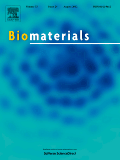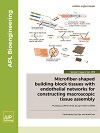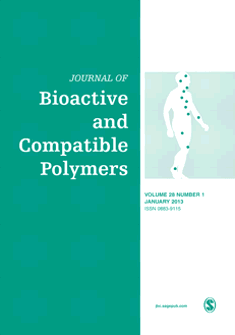
BIOMATERIALS
Scope & Guideline
Elevating Knowledge in the Interdisciplinary World of Biomaterials
Introduction
Aims and Scopes
- Biomaterials for Regenerative Medicine:
Research in this area focuses on the development and application of biomaterials that can support tissue regeneration and repair, including scaffolds, hydrogels, and 3D printed constructs designed to enhance healing in various tissues. - Nanomedicine and Drug Delivery Systems:
This scope encompasses the design and application of nanomaterials for targeted and controlled drug delivery, enhancing therapeutic efficacy while minimizing side effects, particularly in cancer treatment and chronic diseases. - Bioengineering and Tissue Engineering:
The journal highlights studies that integrate engineering principles with biological systems, focusing on the creation of functional tissues and organs, including organ-on-a-chip technologies and bioprinting. - Immunomodulation and Therapeutic Applications:
Research that explores how biomaterials can modulate immune responses to improve therapeutic outcomes, particularly in cancer immunotherapy and regenerative medicine. - Biocompatibility and Safety Evaluation:
The journal publishes studies assessing the biocompatibility, toxicity, and long-term effects of biomaterials in biological systems, which are critical for their clinical translation. - Smart Biomaterials and Responsive Systems:
This area includes the development of materials that respond to environmental stimuli (e.g., pH, temperature, light) for dynamic therapeutic applications.
Trending and Emerging
- Advanced Nanotherapeutics:
There is a growing emphasis on the development of nanomaterials that can deliver drugs or therapeutic agents with high precision, including nanocarriers that enhance the efficacy of immunotherapies and chemotherapies. - 3D Bioprinting and Organ-on-a-Chip Technologies:
The trend towards creating complex tissue structures using 3D bioprinting techniques is increasing, along with the development of organ-on-a-chip systems that mimic human organ functions for drug testing and disease modeling. - Biomaterials for Cancer Immunotherapy:
Research is trending towards the use of biomaterials as platforms for cancer immunotherapy, focusing on how these materials can enhance immune responses and target tumor microenvironments. - Smart and Responsive Biomaterials:
There is an emerging interest in biomaterials that respond to specific stimuli (light, temperature, pH), allowing for on-demand drug release and dynamic therapeutic applications. - Microenvironment Engineering:
An increasing number of studies are focusing on how the engineered microenvironment can influence cell behavior, particularly in the context of stem cell therapy and tissue regeneration. - Sustainable and Green Biomaterials:
There is a rising trend towards developing environmentally friendly biomaterials derived from natural sources, emphasizing sustainability and biocompatibility.
Declining or Waning
- Traditional Biomaterials without Functionalization:
There has been a noticeable decrease in studies focusing solely on traditional biomaterials (such as simple hydrogels or polymers) without advanced functionalization or modification to enhance their properties or applications. - In vitro Studies without Translation to In Vivo Models:
Research that remains solely within in vitro studies without progressing to in vivo validation is declining, as there is a greater emphasis on translational research that can lead to practical applications in clinical settings. - Non-targeted Drug Delivery Approaches:
As precision medicine becomes more prominent, there is a waning interest in non-targeted drug delivery systems, with more focus shifting towards targeted and personalized therapies. - Static Biomaterial Studies:
Static studies that do not incorporate dynamic or responsive elements in biomaterials are becoming less frequent, as there is a growing interest in materials that can adapt to physiological conditions.
Similar Journals

Bioactive Materials
Unlocking the Potential of Bioactive Materials for a Healthier FutureBioactive Materials, published by KEAI PUBLISHING LTD, stands as a leading Open Access journal in the fields of Biomaterials, Biomedical Engineering, and Biotechnology. Since its inception in 2016, this journal has rapidly ascended in prominence, currently holding a prestigious Q1 category ranking across multiple disciplines, reflecting its significant impact within the scientific community. With its E-ISSN 2452-199X, it spans a broad spectrum of research areas, contributing valuable insights to the ongoing discourse in bioactive materials and their applications. The journal's superior Scopus rankings further illustrate its influence, boasting impressive standings in engaging niches such as engineering and molecular biology. Bioactive Materials offers a vital platform for researchers, professionals, and students to disseminate and acquire cutting-edge knowledge, thus fostering innovation and collaboration in the rapidly evolving terrain of biomedicine. Its commitment to Open Access since 2016 enhances accessibility, ensuring that the burgeoning advancements in this field reach a global audience.

APL Bioengineering
Innovating at the Intersection of Science and MedicineAPL Bioengineering is a premier open-access journal published by AIP Publishing, dedicated to advancing the field of bioengineering and its interdisciplinary applications. Established in 2017, this journal serves as a vital platform for researchers, professionals, and students interested in the critical intersections of bioengineering, biomaterials, biomedical engineering, and biophysics. With an impressive impact factor and consistent rankings in the Q1 category across multiple domains, including biochemistry and materials science, APL Bioengineering has positioned itself among the top journals in its field. The journal aims to publish innovative original research, comprehensive reviews, and insightful case studies that further the understanding and application of bioengineering principles. Since its inception, APL Bioengineering has fostered a community of thought leaders, providing open access to ensure broad dissemination of knowledge and advancements that underpin the future of biomedical innovation.

MACROMOLECULAR BIOSCIENCE
Leading the Charge in Macromolecular ScienceMACROMOLECULAR BIOSCIENCE, published by WILEY-V C H VERLAG GMBH, is a leading journal in the fields of bioengineering, biomaterials, biotechnology, materials chemistry, and polymers and plastics. With a convergence of scientific inquiry since its inception in 2001, the journal has established itself as a vital resource for researchers and professionals exploring the interface of molecular sciences and biosystems. It boasts impressive Scopus rankings, including Q1 status in multiple categories, reflecting its significant contribution to advancing knowledge and innovation in the polymer and biomaterials domains. While the journal does not currently offer open access options, its rigorous peer-review process ensures the publication of high-quality research that fuels academic discourse. Positioned in Weinheim, Germany, MACROMOLECULAR BIOSCIENCE aims to bridge theoretical understanding with practical applications, making it an essential reference for students, academics, and industry practitioners dedicated to the evolving landscape of macromolecular bioscience.

Materials Today Bio
Empowering researchers with open access to vital scientific advancements.Materials Today Bio, published by Elsevier, is an esteemed open-access journal dedicated to advancing the fields of bioengineering, biomaterials, and biomedical engineering. Since its inception in 2019, this journal has quickly made a name for itself, currently ranked Q1 in multiple categories including Bioengineering, Biomaterials, and Biotechnology, reflecting its exceptional quality and relevance in the rapidly evolving landscape of bio-related sciences. With an impressive Scopus ranking positioning it in the top 25% of its categories, Materials Today Bio provides a vital platform for researchers and professionals to share cutting-edge discoveries and innovative applications that bridge the gap between materials science and biological studies. Accessible to a global audience, this journal not only fosters collaboration among the scientific community but also aims to highlight significant advancements in cell and molecular biology, making it an indispensable resource for students and seasoned experts alike. The journal's commitment to open access since 2019 underscores its dedication to disseminating knowledge widely, ensuring that crucial findings reach those who can benefit from them the most.

JOURNAL OF BIOACTIVE AND COMPATIBLE POLYMERS
Bridging Disciplines in Polymer ResearchJOURNAL OF BIOACTIVE AND COMPATIBLE POLYMERS, published by SAGE PUBLICATIONS LTD, serves as a pivotal platform for disseminating innovative research in the fields of bioengineering, biomaterials, materials chemistry, and polymers. With an ISSN of 0883-9115 and an E-ISSN of 1530-8030, this journal is committed to the advancement of knowledge relating to the interaction of polymers within biological systems and their compatibility in various applications. Operating since 1986, the journal has garnered a respectable presence, ranked in the Q3 quartile across multiple categories in 2023, indicating its relevance and contribution to these dynamic fields. Although not open access, the journal ensures that high-quality research is accessible to subscribers and institutions, reinforcing its importance for researchers, professionals, and students aiming to stay abreast of advancements in polymer science and biocompatibility. By fostering interdisciplinary communication and collaboration, the JOURNAL OF BIOACTIVE AND COMPATIBLE POLYMERS continues to play a crucial role in shaping the future of material applications in health, technology, and industry.

JOURNAL OF MATERIALS SCIENCE-MATERIALS IN MEDICINE
Advancing Biomedical Innovation through Materials ScienceJOURNAL OF MATERIALS SCIENCE-MATERIALS IN MEDICINE is a leading peer-reviewed journal published by Springer, dedicated to advancing the field of biomedical materials science. With an ISSN of 0957-4530 and E-ISSN 1573-4838, this Open Access journal has been committed to providing researchers and professionals with freely accessible, high-quality research since 2021. It features an extensive scope spanning bioengineering, biomaterials, biomedical engineering, and biophysics, reflecting its significant impact within these interdisciplinary domains. Recognized within the Q2 category of the 2023 rankings in multiple fields, the journal proudly positions itself as a crucial resource for innovative materials that contribute to advancements in medical applications. With impressive Scopus rankings, including 26th in Biophysics and 40th in Materials Science for Biomaterials, researchers, students, and industry professionals alike can rely on this publication for cutting-edge insights that drive the future of medical materials and technologies. Based in Dordrecht, Netherlands, the journal provides a vibrant platform for sharing groundbreaking discoveries and fostering collaborative research among a global audience.

Progress in Biomaterials
Advancing the Future of Biomaterials ResearchProgress in Biomaterials is a premier journal published by Springer Heidelberg, dedicated to advancing the field of biomaterials through the dissemination of high-quality research articles, reviews, and case studies. The journal, with an ISSN of 2194-0509 and an E-ISSN of 2194-0517, holds an esteemed position within both the Biomaterials and Chemical Engineering fields, as evidenced by its rankings in the Q2 and Q1 quartiles, respectively. With its convergence over the years from 2013 to 2023, it has maintained a strong impact on scientific discourse, ranking #15 in Chemical Engineering and #30 in Biomaterials according to Scopus metrics. The journal is based in Heidelberg, Germany, and aims to provide an open platform for interdisciplinary collaboration amongst researchers, professionals, and students alike, fostering innovation and progress in biomaterials research. As a crucial resource for those engaged in this dynamic field, it empowers authors and readers to explore the latest trends, technologies, and applications in biomaterials development.

Tissue Engineering Part B-Reviews
Navigating the Future of Regenerative Medicine Research.Tissue Engineering Part B-Reviews is a premier academic journal published by MARY ANN LIEBERT, INC, focusing on the interdisciplinary field of tissue engineering and regenerative medicine. With an impressive impact factor that places it in the Q1 category across multiple relevant fields—including Biochemistry, Bioengineering, Biomaterials, and Biomedical Engineering—this journal provides a vital platform for researchers and professionals to disseminate cutting-edge findings and comprehensive reviews. Covering a vast scope from 2008 to 2024, the journal is committed to advancing knowledge in the application of engineering principles to biological tissues, making it an indispensable resource for those at the forefront of biomedical innovation. While the journal does not currently offer open access options, its rigorous peer review process ensures high-quality contributions that are essential for academic and practical advancements. The journal's rankings in Scopus reflect its significance, catering to a diverse audience of students, researchers, and practitioners seeking the latest insights in this dynamic field.

International Journal of Biomaterials
Exploring the future of biomedical engineering with cutting-edge studies.The International Journal of Biomaterials, published by HINDAWI LTD, is a premier platform for disseminating groundbreaking research in the fields of biomaterials and biomedical engineering. With an Open Access approach since 2009, this journal provides unhindered access to innovative studies and applications aimed at advancing medical technologies and improving patient outcomes. Notably ranked in the Q3 category for both Biomaterials and Biomedical Engineering in 2023, it serves as an essential resource for researchers, practitioners, and students alike. The journal's Scopus rankings, including a 49th percentile in Biomedical Engineering and a 40th percentile in Biomaterials, further underscore its growing prominence in the academic community. With contributions spanning from 2011 to 2024, the journal seeks to foster collaborative research and promote developments that enhance the understanding and application of biomaterials in healthcare.

Advanced NanoBiomed Research
Uniting Engineering and Medicine for BreakthroughsAdvanced NanoBiomed Research is a pioneering open-access journal committed to advancing the interdisciplinary field of nanobiotechnology, published by WILEY-V C H VERLAG GMBH. Since its inception in 2021, this journal has provided a platform for innovative research that bridges the gap between engineering, medicine, and materials science. With impressive rankings in Scopus, positioning it within the top quartiles of various categories, Advanced NanoBiomed Research aims to disseminate high-quality research that contributes to the understanding and application of nanomaterials in biomedical contexts. As it encompasses a wide scope—from applied microbiology to biomaterials—it serves as an essential resource for researchers, professionals, and students eager to explore the cutting-edge developments in the field. The journal promotes a collaborative environment where emerging ideas can flourish, ensuring that vital advancements in nanobiomedicine can be shared and built upon within the scientific community.